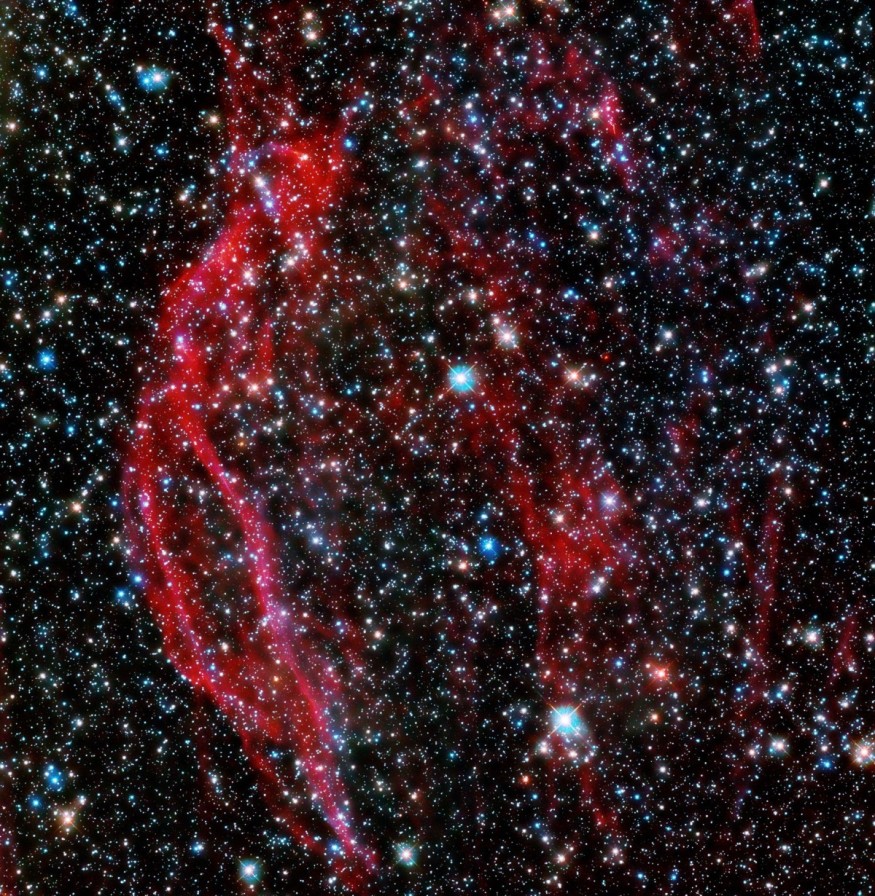The Hubble Space Telescope captured a new image of a magnificent cosmic presentation. The photograph from space displayed a massive stellar explosion of stars. Along with the stellar cluster, some emissions emitted a glowing red color which brightened the surrounding void. The explosion was identified as the supernova remnant DEM L249 and was charted from the cosmic region in the Large Magellanic Cloud.
Type 1a Supernova Remnants DEM L249 Inside the Large Magellanic Cloud

The bright glow of reddish clouds and dust in the image was identified as the aftermath of a catastrophic explosion. According to the National Aeronautics and Space Administration, the red ribbon explosion is indeed remnants of a dead white dwarf. The explosions from the specified stellar bodies are considered to be more powerful than the standard supernovas that occur across the universe.
The glowing exhibit is known as the DEM L249, and currently hovers inside the confines of the famous Large Magellanic Cloud or LMC. Due to the capacity of the explosion that white dwarfs could produce, the red glow of the DEM L249 was confirmed as leftovers of a Type 1a supernova.
The Large Magellanic Cloud is considered a satellite dwarf galaxy under the greater realm of the Milky Way. The distance between our galaxy and the LMC is estimated to stretch at 160,000 light-years. The measure of the Large Magellanic Cloud makes it among the nearest galaxies to Earth, making the red stellar explosion DEM L249 also close to the planet.
Based on a report by Space, experts from NASA said that the Hubble Space Telescope was able to capture the red ribbon unintentionally while it is being utilized in observation of the greater regions of the Large Magellanic Clouds. The said project is conducted to find and record white dwarfs and their relatives that have already exploded.
ALSO READ : NASA Mars Perseverance Rover Cleanly Scrapes A Martian Rock To See Something 'No One's Ever Seen'
Neighboring Supernova Remnants Caused by Young White Dwarf or Explosion of Binary System; Gas in DEM L249 Hotter than Expected
NASA experts informed that the white dwarfs are frequently found to have a stable state. However, some white dwarfs are known to explode on their own when they are placed in a space that has a binary system. This setup is comprised of two giant stars in a single domain, but as impossible as it seems, several galaxies have binary arrangements.
But there is one thing that endangers this scenario. The presence of two massive white dwarfs could pull each other, leading to the star with a greater gravitational pull to eventually suck up the entirety of its companion. When this happens, the greater star would inherit all of the mass, and upon reaching a critical rate, it would explode into a supernova that would cause a more powerful impact than the standard bursts.
The DEM L249 is among the rare supernova remnants in space. Astronomers believe the red ribbon is fragments of a young white dwarf that had developed into a supernova earlier than expected inside the vast section of the Large Magellanic Cloud.
The red ribbon of dust and clouds were discovered by Hubble as part of the collaborative study of NASA's Chandra X-ray Observatory and the European Space Agency's (ESA) XMM-Newton space observatory. Among the aspects of DEM L249 that caught the interest of the experts is that the gas present on the cluster has higher temperatures compared to other known remnants of Type 1a supernovas.
RELATED ARTICLE : Thomas Pesquet Sets Longest European Spacewalk Record Outside ISS; Astronaut Wants To Explore Moon and Mars
Check out more news and information on Space in Science Times.












